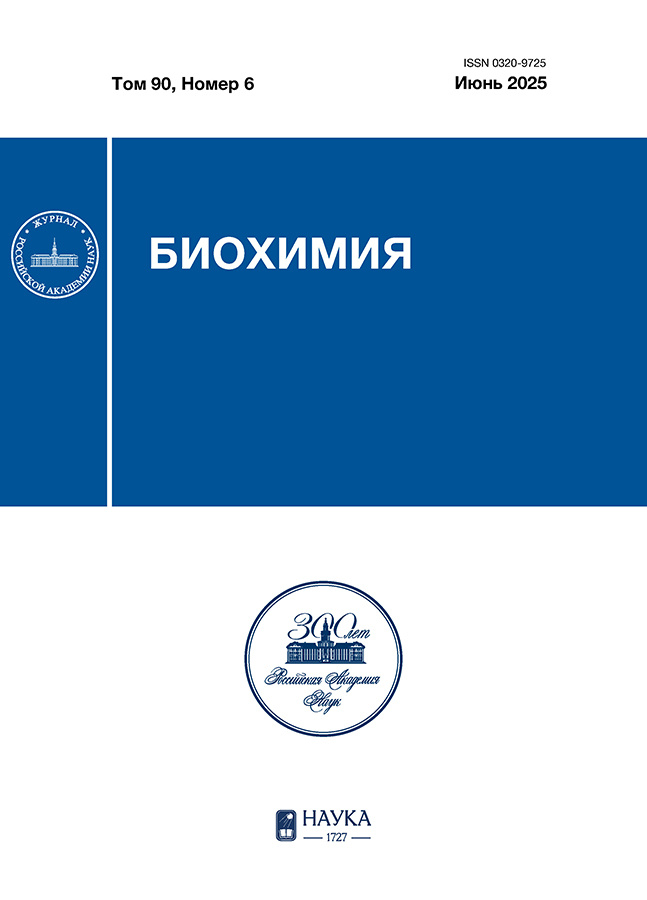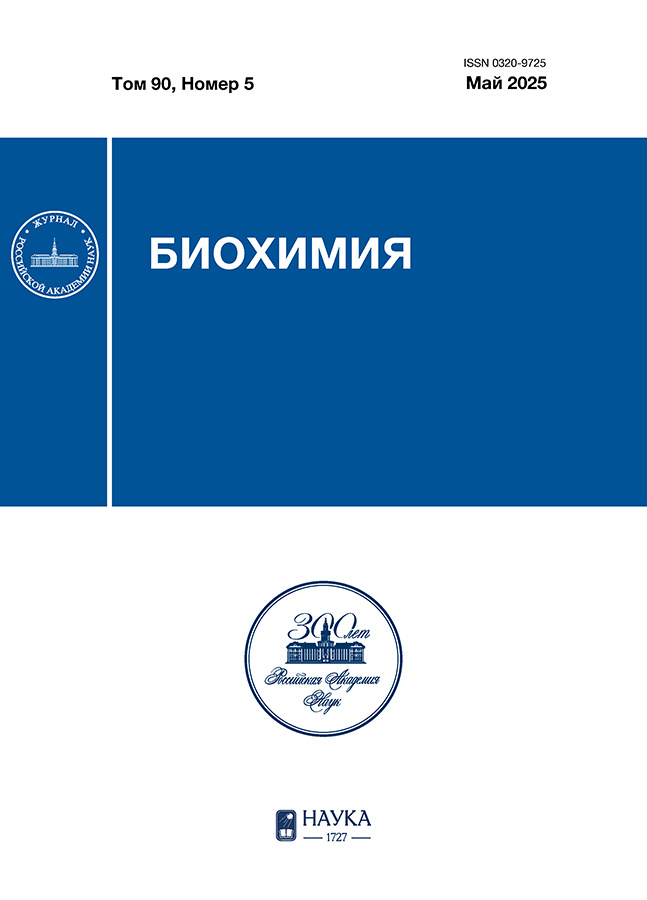Glycerol kinase overexpression supresses lipid synthesis but enlarges mitochondrial membrane potential and thermogenesis activity in adipocytes
- Authors: Michurina S.S.1, Beloglazova I.B.1, Agareva M.Y.1,2, Mohammad R.3, Alekseeva N.V.4, Parfyonova E.V.1,2, Stafeev I.S.1
-
Affiliations:
- National Medical Research Centre for Cardiology Named after Academician E.I. Chazov
- Faculty of Basic Medicine, Lomonosov Moscow State University
- Moscow Institute of Physics and Technology (National Research University)
- Faculty of Biology, Lomonosov Moscow State University
- Issue: Vol 90, No 5 (2025)
- Pages: 673-687
- Section: Articles
- URL: https://kazanmedjournal.ru/0320-9725/article/view/686546
- DOI: https://doi.org/10.31857/S0320972525050079
- EDN: https://elibrary.ru/ISJIEA
- ID: 686546
Cite item
Abstract
Obesity and type 2 diabetes mellitus are among the main factors contributing to the increase in mortality and disability in the modern world. Therefore, it is a priority to develop new methods, including genetic and cellular engineering, to create ectopic thermogenic fat depots capable of dissipating excess energy. In this study, we overexpressed glycerol kinase (GK), a key enzyme of the futile triacylglyceride cycle (TAG cycle) to generate thermogenic adipocytes. The protein-coding sequence of GK was amplified from mouse liver mRNA and delivered to adipocytes by lentiviral transduction. Adipocyte metabolism was analyzed by radioisotope monitoring of [3H]- and [14C]-labelled glucose analogues. Mitochondrial membrane potential, thermogenesis and lipid droplet morphology were assessed using fluorescent probes JC-1, ERthermAC and BODIPY493/503, respectively. Lentiviral delivery of the GK gene increases mRNA expression 130-fold and protein levels by 30% in adipocytes. GK overexpression enhances glucose uptake by adipocytes and suppresses fatty acids synthesis and re-esterification without altering lipid droplet morphology. The increase in glucose uptake upon GK overexpression is associated with an increase in mitochondrial potential and stimulation of thermogenesis. GK overexpression improves the metabolic profile of adipocytes, which may contribute to the elimination of metabolic disorders associated with obesity by increasing the utilization of excess glucose during thermogenesis. Nevertheless, the detailed mechanisms underlying the stimulation of these processes require further investigation.
Full Text
About the authors
S. S. Michurina
National Medical Research Centre for Cardiology Named after Academician E.I. Chazov
Email: yuristafeev@gmail.com
Russian Federation, 121500 Moscow
I. B. Beloglazova
National Medical Research Centre for Cardiology Named after Academician E.I. Chazov
Email: yuristafeev@gmail.com
Russian Federation, 121500 Moscow
M. Yu. Agareva
National Medical Research Centre for Cardiology Named after Academician E.I. Chazov; Faculty of Basic Medicine, Lomonosov Moscow State University
Email: yuristafeev@gmail.com
Russian Federation, 121500 Moscow; 119991 Moscow
R. Mohammad
Moscow Institute of Physics and Technology (National Research University)
Email: yuristafeev@gmail.com
Russian Federation, 117303 Dolgoprudny, Moscow Region
N. V. Alekseeva
Faculty of Biology, Lomonosov Moscow State University
Email: yuristafeev@gmail.com
Russian Federation, 119991 Moscow
E. V. Parfyonova
National Medical Research Centre for Cardiology Named after Academician E.I. Chazov; Faculty of Basic Medicine, Lomonosov Moscow State University
Email: yuristafeev@gmail.com
Russian Federation, 121500 Moscow; 119991 Moscow
I. S. Stafeev
National Medical Research Centre for Cardiology Named after Academician E.I. Chazov
Author for correspondence.
Email: yuristafeev@gmail.com
Russian Federation, 121500 Moscow
References
- Lingvay, I., Cohen, R. V., le Roux, C. W., and Sumithran, P. (2024) Obesity in adults, Lancet, 404, 972-987, https://doi.org/10.1016/S0140-6736(24)01210-8.
- Strati, M., Moustaki, M., Psaltopoulou, T., Vryonidou, A., and Paschou, S. A. (2024) Early onset type 2 diabetes mellitus: an update, Endocrine, 85, 965-978, https://doi.org/10.1007/s12020-024-03772-w.
- Nunn, E. R., Shinde, A. B., and Zaganjor, E. (2022) Weighing in on adipogenesis, Front. Physiol., 13, 821278, https://doi.org/10.3389/fphys.2022.821278.
- Smith, U., and Kahn, B. B. (2016) Adipose tissue regulates insulin sensitivity: role of adipogenesis, de novo lipogenesis and novel lipids, J. Intern. Med., 280, 465-475, https://doi.org/10.1111/joim.12540.
- Šiklová, M., Šrámková, V., Koc, M., Krauzová, E., Čížková, T., Ondrůjová, B., Wilhelm, M., Varaliová, Z., Kuda, O., Neubert, J., Lambert, L., Elkalaf, M., Gojda, J., and Rossmeislová, L. (2024) The role of adipogenic capacity and dysfunctional subcutaneous adipose tissue in the inheritance of type 2 diabetes mellitus: cross-sectional study, Obesity, 32, 547-559, https://doi.org/10.1002/oby.23969.
- Shao, M., Wang, Q. A., Song, A., Vishvanath, L., Busbuso, N. C., Scherer, P. E., and Gupta, R. K. (2019) Cellular origins of beige fat cells revisited, Diabetes, 68, 1874-1885, https://doi.org/10.2337/db19-0308.
- Maurer, S., Harms, M., and Boucher, J. (2021) The colorful versatility of adipocytes: white-to-brown transdifferentiation and its therapeutic potential in humans, FEBS J., 288, 3628-3646, https://doi.org/10.1111/febs.15470.
- Wu, R., Park, J., Qian, Y., Shi, Z., Hu, R., Yuan, Y., Xiong, S., Wang, Z., Yan, G., Ong, S. G., Song, Q., Song, Z, Mahmoud, A.M., Xu, P., He, C., Arpke, R. W., Kyba, M., Shu, G., Jiang, Q., and Jiang, Y. (2023) Genetically prolonged beige fat in male mice confers long-lasting metabolic health, Nat. Commun., 14, 2731, https://doi.org/ 10.1038/s41467-023-38471-z.
- Nedergaard, J., Golozoubova, V., Matthias, A., Asadi, A., Jacobsson, A., and Cannon, B. (2001) UCP1: the only protein able to mediate adaptive non-shivering thermogenesis and metabolic inefficiency, Biochem. Biophys. Acta, 1504, 82-106, https://doi.org/10.1016/s0005-2728(00)00247-4.
- Michurina, S., Stafeev, I., Boldyreva, M., Truong, V. A., Ratner, E., Menshikov, M., Hu, Y. C., and Parfyonova, Ye. (2023) Transplantation of adipose-tissue-engineered constructs with CRISPR-mediated UCP1 activation, Int. J. Mol. Sci., 24, 3844, https://doi.org/10.3390/ijms24043844.
- Ikeda, K., Kang, Q., Yoneshiro T., Camporez, J. P., Maki, H., Homma, M., Shinoda, K., Chen, Y., Lu, X., Maretich, P., Tajima, K., Ajuwon, K. M., Soga, T., and Kajimura, S. (2017) UCP1-independent signaling involving SERCA2b-mediated calcium cycling regulates beige fat thermogenesis and systemic glucose homeostasis, Nat. Med., 23, 1454-1465, https://doi.org/10.1038/nm.4429.
- Brownstein, A. J., Veliova, M., Acin-Perez, R., Liesa, M., and Shirihai, O. S. (2022) ATP-consuming futile cycles as energy dissipating mechanisms to counteract obesity, Rev. Endocr. Metab. Disord., 23, 121-131, https://doi.org/10.1007/s11154-021-09690-w.
- Roesler, A., and Kazak, L. (2020) UCP1-independent thermogenesis, Biochem. J., 477, 709-725, https://doi.org/10.1042/BCJ20190463.
- Steinberg, D., Vaughan, M., Margolis, S., Price, H., and Pittman, R. (1961) Studies of triglyceride biosynthesis in homogenates of adipose tissue, J. Biol. Chem., 236, 1631-1637, https://doi.org/10.1016/S0021-9258(19)63276-X.
- Jéquier, E., and Tappy, L. (1998) Regulation of body weight in humans, Physiol. Rev., 79, 451-480, https://doi.org/10.1152/physrev.1999.79.2.451.
- Chakrabarty, K., Chaudhuri, B., and Jeffay, H. (1983) Glycerokinase activity in human brown adipose tissue, J. Lipid. Res., 24, P381-390, https://doi.org/10.1016/S0022-2275(20)37978-5.
- Festuccia, W. T. L., Guerra-Sá, R., Kawashita, N. H., Garófalo, M. A. R., Evangelista, E. A., Rodrigues, V., Kettelhut, I. C., and Migliorini, R. H. (2003) Expression of glycerokinase in brown adipose tissue is stimulated by the sympathetic nervous system, Am. J. Physiol. Regul. Integr. Comp. Physiol., 284, R1536-R1541, https://doi.org/10.1152/ajpregu.00764.2002.
- Iwase, M., Tokiwa, S., Seno, S., Mukai, T., Yeh, Y. S., Takahashi, H., Nomura, W., Jheng, H. F., Matsumura, S., Kusudo, T., Osato, N., Matsuda, H., Inoue, K., Kawada, T., and Goto, T. (2020) Glycerol kinase stimulates uncoupling protein 1 expression by regulating fatty acid metabolism in beige adipocytes, J. Biol. Chem., 295, P7033-P7045, https://doi.org/10.1074/jbc.RA119.011658.
- Sharma, A. K., Khandelwal, R., and Wolfrum, C. (2024) Futile lipid cycling: from biochemistry to physiology, Nat. Metab., 6, 808-824, https://doi.org/10.1038/s42255-024-01003-0.
- Guan, H. P., Li, Y., Jensen, M. V., Newgard, C. B., Steppan, C. M., and Lazar, M. A. (2002) A futile metabolic cycle activated in adipocytes by antidiabetic agents, Nat. Med., 8, 1122-1128, https://doi.org/10.1038/nm780.
- Leroyer, S.N., Tordjman, J., Chauvet, G., Quette, J., Chapron, C., Forest, C., and Antoine, B. (2006) Rosiglitazone controls fatty acid cycling in human adipose tissue by means of glyceroneogenesis and glycerol phosphorylation, J. Biol. Chem., 281, 13141-13149, https://doi.org/10.1074/jbc.M512943200.
- Song, N. J., Chang, S. H., Li, D. Y., Villanueva, C. J., and Park, K. W. (2017) Induction of thermogenic adipocytes: molecular targets and thermogenic small molecules, Exp. Mol. Med., 49, e353, https://doi.org/10.1038/emm.2017.70.
- Deis, J. A., Guo, H., Wu, Y., Liu, C., Bernlohr, D. A., and Chen, X. (2019) Adipose Lipocalin 2 overexpression protects against age-related decline in thermogenic function of adipose tissue and metabolic deterioration, Mol. Metab., 24, 18-29, https://doi.org/10.1016/j.molmet.2019.03.007.
- Díez-Sainz, E., Milagro, F. I., Aranaz, P., Riezu-Boj, J. I., Batrow, P. L., Contu, L., Gautier, N., Amri, E. Z., Mothe-Satney, I., and Lorente-Cebrián, S. (2024) Human miR-1 stimulates metabolic and thermogenic-related genes in adipocytes, Int. J. Mol. Sci., 26, 276, https://doi.org/10.3390/ijms26010276.
- Zebisch, K., Voigt, V., Wabitsch, M., and Brandsch, M. (2012) Protocol for effective differentiation of 3T3-L1 cells to adipocytes, Anal. Biochem., 425, 88-90, https://doi.org/10.1016/j.ab.2012.03.005.
- Schmittgen, T. D., and Livak, K. J. (2008) Analyzing real-time PCR data by the comparative C(T) method, Nat. Protoc., 3, 1101-1108, https://doi.org/10.1038/nprot.2008.73.
- Laemmli, U. K. (1970) Cleavage of structural proteins during the assembly of the head of bacteriophage T4, Nature, 227, 680-685, https://doi.org/10.1038/227680a0.
- Michurina, S., Goltseva, Y., Ratner, E., Dergilev, K., Shestakova, E., Minniakhmetov, I., Rumyantsev, S., Stafeev, I., Shestakova, M., and Parfyonova, Ye. (2025) Artificial intelligence – enabled lipid droplets quantification: comparative analysis of NIS-Elements Segment.ai and ZeroCostDL4Mic StarDist networks for confocal images, Methods, 237, 9-18, https://doi.org/10.1016/j.ymeth.2025.02.013.
- Kriszt, R., Arai, S., Itoh, H., Lee, M. H., Goralczyk, A. G., Ang, X. M., Cypess, A. M., White, A. P., Shamsi, F., Xue, R., Lee, J. Y., Lee, S. C., Hou, Y., Kitaguchi, T., Sudhaharan, T., Ishiwata, S., Lane, E. B., Chang, Y. T., Tseng, Y. H., Suzuki, M., and Raghunath, M. (2017) Optical visualisation of thermogenesis in stimulated single-cell brown adipocytes, Sci. Rep., 7, 1383, https://doi.org/10.1038/s41598-017-00291-9.
- Michurina, S., Agareva, M., Ratner, E., Menshikov, M., Stafeev, I., and Parfyonova, Ye. (2024) The simple method of lipolysis/lipogenesis balance assessment based on 14C isotope: advances and importance of pH control, J. Radioanal. Nucl. Chem., 333, 125-134, https://doi.org/10.1007/s10967-023-09198-4.
- Stern, J. S., Hirsch, J., Drewnowski, A., Sullivan, A. C., Johnson, P. R., and Cohn, C. K. (1983) Glycerol kinase activity in adipose tissue of obese rats and mice: effects of diet composition, J. Nutr., 113, 714-720, https://doi.org/10.1093/jn/113.3.714.
- Iena, F. M., Jul, J. B., Vegger, J. B., Lodberg, A., Thomsen, J. S., Brüel, A., and Lebeck, J. (2020) Sex-specific effect of high-fat diet on glycerol metabolism in murine adipose tissue and liver, Front. Endocrinol., 11, 577650, https://doi.org/10.3389/fendo.2020.577650.
- Talley, J. T., and Mohiuddin, S. (2023) Biochemistry, Fatty Acid Oxidation, StatPearls.
- Alves-Bezerra, M., and Cohen, D.E. (2017) Triglyceride metabolism in the liver, Compr. Physiol., 8, 1-8, https://doi.org/10.1002/cphy.c170012.
- Rotondo, F., Ho-Palma, A. C., Remesar, X., Fernández-López, J. A., Romero, M. D. M., and Alemany, M. (2017) Glycerol is synthesized and secreted by adipocytes to dispose of excess glucose, via glycerogenesis and increased acyl-glycerol turnover, Sci. Rep., 7, 8983, https://doi.org/10.1038/s41598-017-09450-4.
- Mottillo, E. P., Balasubramanian, P., Lee, Y. H., Weng, C., Kershaw, E. E., and Granneman, J. G. (2014) Coupling of lipolysis and de novo lipogenesis in brown, beige, and white adipose tissues during chronic β3-adrenergic receptor activation, J. Lipid. Res., 55, 2276-2286, https://doi.org/10.1194/jlr.M050005.
- Guilherme, A., Rowland, L. A., Wang, H., and Czech, M. P. (2023) The adipocyte supersystem of insulin and cAMP signaling, Trends Cell. Biol., 33, 340-354, https://doi.org/10.1016/j.tcb.2022.07.009.
- Mathiowetz, A. J., and Olzmann, J. A. (2024) Lipid droplets and cellular lipid flux, Nat. Cell. Biol., 26, 331-345, https://doi.org/10.1038/s41556-024-01364-4.
- Lin, M. H., Romsos, D. L., and Leveille, G. A. (1976) Effect of glycerol on lipogenic enzyme activities and on fatty acid synthesis in the rat and chicken, J. Nutr., 106, 1668-1677, https://doi.org/10.1093/jn/ 106.11.1668.
- Ouyang, S., Zhuo, S., Yang, M., Zhu, T., Yu, S., Li, Y., Ying, H., and Le, Y. (2024) Glycerol kinase drives hepatic de novo lipogenesis and triglyceride synthesis in nonalcoholic fatty liver by activating SREBP-1c transcription, upregulating DGAT1/2 expression, and promoting glycerol metabolism, Adv. Sci. (Weinh)., 11, e2401311, https://doi.org/10.1002/advs.202401311.
Supplementary files

















